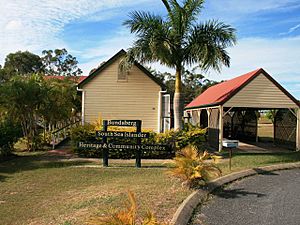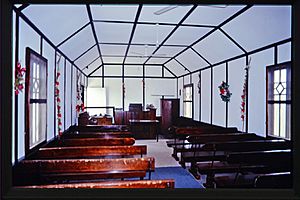South Sea Islander Church facts for kids
Quick facts for kids South Sea Islander Church and Hall |
|
|---|---|

South Sea Islander Church and Hall, 2009
|
|
| Location | 46 Johnston Street, Millbank, Bundaberg, Bundaberg Region, Queensland, Australia |
| Design period | 1919–1930s (interwar period) |
| Built | c. 1920 |
| Official name: South Sea Islander Church and Hall | |
| Type | state heritage (built) |
| Designated | 28 July 2000 |
| Reference no. | 602052 |
| Significant period | 1920s (historical) 1920s–ongoing (social) |
| Significant components | furniture/fittings, church, church hall/sunday school hall |
| Lua error in Module:Location_map at line 420: attempt to index field 'wikibase' (a nil value). | |
The South Sea Islander Church and Hall is a special historical building. It is located at 46 Johnston Street in Millbank, Bundaberg, Queensland, Australia. This church and hall were built around 1920. They were added to the Queensland Heritage Register on July 28, 2000. This means they are recognized as important historical places.
Contents
A Special Place for Islanders
The Fairymead Plantation Story
The South Sea Islander Church and Hall were first built around 1920. They were located on the Fairymead sugar plantation. These buildings were made for the spiritual needs of the South Sea Islander people. Many of these people worked as labourers on the plantation.
The land for the Fairymead plantation was once a cattle property called "Tantitha". The Young family bought this land. In 1882, Arthur, Horace, and Ernest Young harvested their first sugar cane crop. Fairymead became a full sugar mill in 1884. Later, in 1912, Fairymead became a public company called Fairymead Sugar Company.
Florence Young and the Mission
Florence Young was the sister of the Young family who started Fairymead. She was very involved in helping the South Sea Islander community. Florence was the secretary of the Queensland Kanaka Mission (QKM). She taught religious and educational classes to the Islanders. She later did missionary work in other Pacific islands and Asia.
In 1895, it was noted that large plantations like Fairymead provided churches and schools for their South Sea Islander workers. Christianity was spreading among them. Florence Young was born in 1856. She moved to Fairymead in 1882. Soon after, she started prayer meetings for the families there.
Young taught classes using simple language and pictures. She used biblical phrases to explain important ideas. The Queensland Kanaka Mission (QKM) officially started at Fairymead in 1886. It was a non-denominational church. The QKM wanted to prepare South Sea Islanders for Christian churches when they returned home. At its busiest, around 1904-1905, the QKM had many missionaries and teachers. They reported many people becoming Christians.
A New Home for the Church
The church and hall were built around 1920. They replaced an older hall on the Fairymead plantation. These buildings show the lasting impact of Christian missionaries in the Bundaberg area.
In 1995, the South Sea Islander Church and Hall were moved. They are now at their current location, a special part of the Bundaberg Cemetery. Many South Sea Islander people are buried there. The church and hall are still used by the South Sea Islander community today. They are an important link to their ancestors' experiences.
What the Church and Hall Look Like
The South Sea Islander Church is a single-story building made of timber. It stands on concrete stumps. The roof has a gabled shape and is covered with corrugated iron. The outside of the church is covered with chamferboards. There are louvred timber vents high up on the west and east ends.
The north and south sides have two sets of casement windows. Each window has a simple, diamond shape design in the middle. There is an entry door and timber stairs at each end of the church on the south side. A ramp has also been added recently for easier access.
Inside, the timber walls of the church are painted white. The timber frame is stained. The church still has its original timber pews, a timber altar, and an organ.
The hall is also a single-story timber building. It sits on concrete stumps. Its roof is also gabled and covered with corrugated iron. The hall is covered with weatherboards. There are double-hung sash windows on the west, east, and south sides. Inside, you can see the building's timber frame because the walls are single-layered. The floor is made of timber. A timber staircase is on the south side of the building.
Both buildings are in a lovely setting. There are landscaped garden beds dedicated to different families.
Why This Place is Important
The South Sea Islander Church and Hall were listed on the Queensland Heritage Register on July 28, 2000. This means they meet certain important standards.
- Shows Queensland's History: These buildings are a good example of a simple missionary church and hall. They are important because they are strongly connected to the South Sea Islander community. This community was a large workforce in the Bundaberg sugar district in the late 1800s and early 1900s. The church and hall are a strong link for today's local South Sea Islander community to their ancestors' experiences in Queensland.
- Shows Key Features of Such Places: They are a good, well-preserved example of a simple missionary church and hall.
- Has Aesthetic Value: The church and hall are located in beautiful grounds. These include garden beds dedicated to various families. This adds to the beauty of the site. Inside the church, the original timber pews, altar, and organ also make it beautiful.
- Strong Connection to a Community: The South Sea Islander Church and Hall were moved to be closer to the graves of South Sea Islander ancestors. They are important because they continue to be used for ancestral worship.


